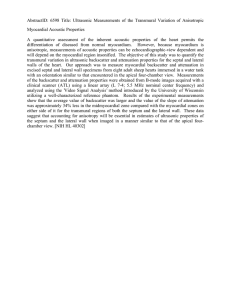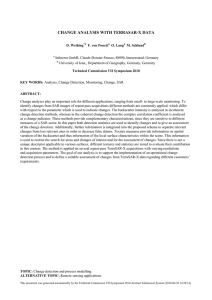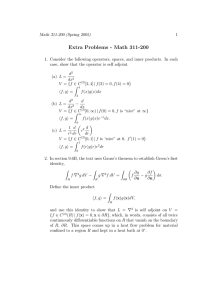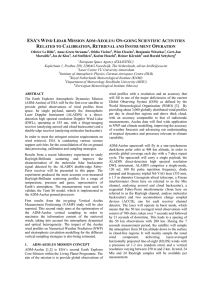advertisement
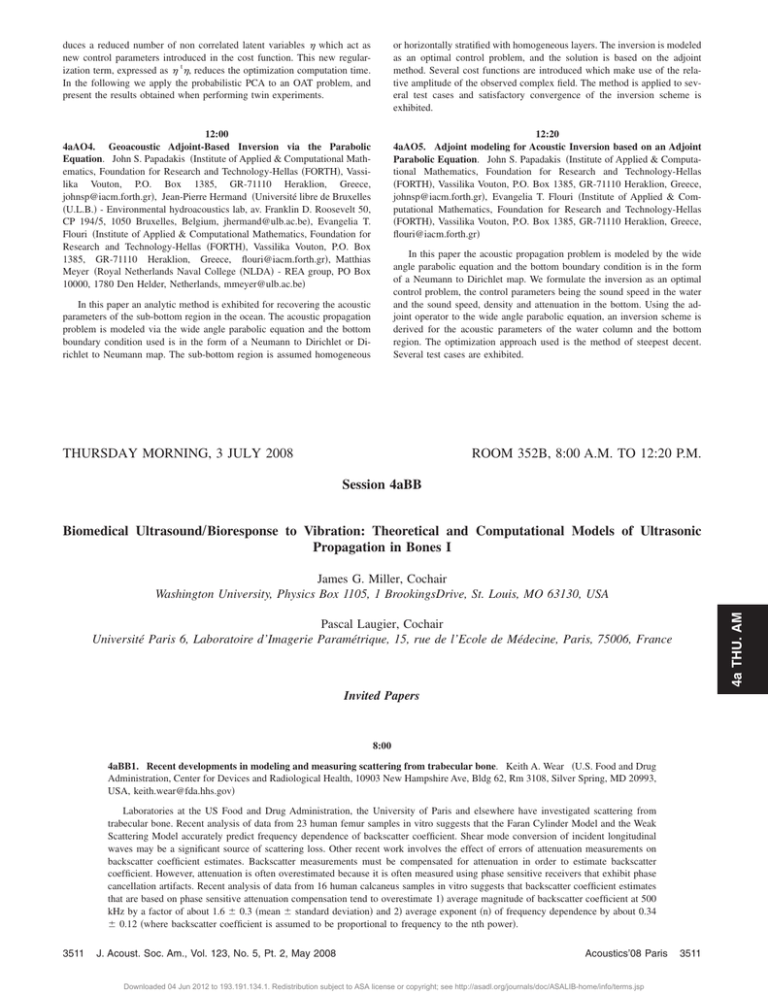
duces a reduced number of non correlated latent variables which act as new control parameters introduced in the cost function. This new regularization term, expressed as t, reduces the optimization computation time. In the following we apply the probabilistic PCA to an OAT problem, and present the results obtained when performing twin experiments. or horizontally stratified with homogeneous layers. The inversion is modeled as an optimal control problem, and the solution is based on the adjoint method. Several cost functions are introduced which make use of the relative amplitude of the observed complex field. The method is applied to several test cases and satisfactory convergence of the inversion scheme is exhibited. 12:00 4aAO4. Geoacoustic Adjoint-Based Inversion via the Parabolic Equation. John S. Papadakis 共Institute of Applied & Computational Mathematics, Foundation for Research and Technology-Hellas 共FORTH兲, Vassilika Vouton, P.O. Box 1385, GR-71110 Heraklion, Greece, johnsp@iacm.forth.gr兲, Jean-Pierre Hermand 共Université libre de Bruxelles 共U.L.B.兲 - Environmental hydroacoustics lab, av. Franklin D. Roosevelt 50, CP 194”5, 1050 Bruxelles, Belgium, jhermand@ulb.ac.be兲, Evangelia T. Flouri 共Institute of Applied & Computational Mathematics, Foundation for Research and Technology-Hellas 共FORTH兲, Vassilika Vouton, P.O. Box 1385, GR-71110 Heraklion, Greece, flouri@iacm.forth.gr兲, Matthias Meyer 共Royal Netherlands Naval College 共NLDA兲 - REA group, PO Box 10000, 1780 Den Helder, Netherlands, mmeyer@ulb.ac.be兲 12:20 4aAO5. Adjoint modeling for Acoustic Inversion based on an Adjoint Parabolic Equation. John S. Papadakis 共Institute of Applied & Computational Mathematics, Foundation for Research and Technology-Hellas 共FORTH兲, Vassilika Vouton, P.O. Box 1385, GR-71110 Heraklion, Greece, johnsp@iacm.forth.gr兲, Evangelia T. Flouri 共Institute of Applied & Computational Mathematics, Foundation for Research and Technology-Hellas 共FORTH兲, Vassilika Vouton, P.O. Box 1385, GR-71110 Heraklion, Greece, flouri@iacm.forth.gr兲 In this paper the acoustic propagation problem is modeled by the wide angle parabolic equation and the bottom boundary condition is in the form of a Neumann to Dirichlet map. We formulate the inversion as an optimal control problem, the control parameters being the sound speed in the water and the sound speed, density and attenuation in the bottom. Using the adjoint operator to the wide angle parabolic equation, an inversion scheme is derived for the acoustic parameters of the water column and the bottom region. The optimization approach used is the method of steepest decent. Several test cases are exhibited. In this paper an analytic method is exhibited for recovering the acoustic parameters of the sub-bottom region in the ocean. The acoustic propagation problem is modeled via the wide angle parabolic equation and the bottom boundary condition used is in the form of a Neumann to Dirichlet or Dirichlet to Neumann map. The sub-bottom region is assumed homogeneous THURSDAY MORNING, 3 JULY 2008 ROOM 352B, 8:00 A.M. TO 12:20 P.M. Session 4aBB Biomedical Ultrasound”Bioresponse to Vibration: Theoretical and Computational Models of Ultrasonic Propagation in Bones I 4a THU. AM James G. Miller, Cochair Washington University, Physics Box 1105, 1 BrookingsDrive, St. Louis, MO 63130, USA Pascal Laugier, Cochair Université Paris 6, Laboratoire d’Imagerie Paramétrique, 15, rue de l’Ecole de Médecine, Paris, 75006, France Invited Papers 8:00 4aBB1. Recent developments in modeling and measuring scattering from trabecular bone. Keith A. Wear 共U.S. Food and Drug Administration, Center for Devices and Radiological Health, 10903 New Hampshire Ave, Bldg 62, Rm 3108, Silver Spring, MD 20993, USA, keith.wear@fda.hhs.gov兲 Laboratories at the US Food and Drug Administration, the University of Paris and elsewhere have investigated scattering from trabecular bone. Recent analysis of data from 23 human femur samples in vitro suggests that the Faran Cylinder Model and the Weak Scattering Model accurately predict frequency dependence of backscatter coefficient. Shear mode conversion of incident longitudinal waves may be a significant source of scattering loss. Other recent work involves the effect of errors of attenuation measurements on backscatter coefficient estimates. Backscatter measurements must be compensated for attenuation in order to estimate backscatter coefficient. However, attenuation is often overestimated because it is often measured using phase sensitive receivers that exhibit phase cancellation artifacts. Recent analysis of data from 16 human calcaneus samples in vitro suggests that backscatter coefficient estimates that are based on phase sensitive attenuation compensation tend to overestimate 1兲 average magnitude of backscatter coefficient at 500 kHz by a factor of about 1.6 ⫾ 0.3 共mean ⫾ standard deviation兲 and 2兲 average exponent 共n兲 of frequency dependence by about 0.34 ⫾ 0.12 共where backscatter coefficient is assumed to be proportional to frequency to the nth power兲. 3511 J. Acoust. Soc. Am., Vol. 123, No. 5, Pt. 2, May 2008 Acoustics’08 Paris Downloaded 04 Jun 2012 to 193.191.134.1. Redistribution subject to ASA license or copyright; see http://asadl.org/journals/doc/ASALIB-home/info/terms.jsp 3511
